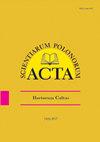田间栽培中不同农艺处理对野生大蒜叶片生长的影响
IF 0.7
4区 农林科学
Q4 HORTICULTURE
引用次数: 0
摘要
野生大蒜(Allium ursinum L.)是一种典型的春季水生植物,其自然栖息地为山毛榉林。这项研究旨在评估在与野生大蒜所需条件明显不同的田间条件下,使用环保和非常规处理方法种植野生大蒜的可能性。本研究旨在评估选定的农业实践(捕捞作物、遮荫植物、生物补偿)对田间野生大蒜叶生长的影响。结果表明,就叶产量而言,在田间条件下栽培野生大蒜时,捕获作物和遮荫植物的生物量以及海藻的生物补偿是合理的。在结构不稳定的集水区土壤上播种阶段生物量对野生大蒜的生长有积极影响,增加了叶片的长度、数量以及叶片的长度和宽度。用作遮荫植物的冬萝卜油菜导致叶片长度和FV/FM指数(可变荧光与最大荧光的商)的值增加,并且根据研究年份,大蒜叶片的长度和宽度也增加。在种植前用“Kelpak SL”溶液浸泡球茎,可以增加种植第二年和第三年在没有萝卜油菜覆盖的情况下生长的大蒜叶的数量。在植被生长的第一年,较长的叶片和较大的叶片确保了在不预先浸泡球茎的情况下喷洒三次制剂。考虑到生物修复对大蒜叶片生长的积极影响和FV/FM比值,在干旱年份的增加情况下,它们的使用是有前景的,是植物灌溉的替代方案。本文章由计算机程序翻译,如有差异,请以英文原文为准。
The impact of selected agrotechnical treatments on the growth of wild garlic (Allium ursinum L.) leaves in field cultivation
Wild garlic (Allium ursinum L.) is a typical spring geophyte whose natural habitat is beech forests. The research aimed to assess the possibility of cultivating wild garlic in field conditions significantly different from those required by this plant, using environmentally friendly and unconventional treatments. This study aimed to evaluate the effect of selected agricultural practices (catch crop, shading plant, biopreparations) on the growth of wild garlic leaves grown in the field.
The results show that the biomass of catch crops and shade plants and biopreparations from marine algae are justified in cultivating wild garlic in field conditions regarding the leaf yield. Ploughing of phacelia biomass on a catchment soil with an unstable structure positively affected the growth of wild garlic, increasing the length of leaves, their number, and the length and width of the leaf blade. Winter turnip rape used as a shade plant caused an increase in the length of the leaves and the value of the FV/FM index (the quotient of the variable fluorescence to the maximum fluorescence), and also, depending on the year of the study, the length and width of the garlic leaf blade. Soaking the bulbs before planting in the ‘Kelpak SL’ solution increased the number of garlic leaves growing without turnip rape cover in the second and third years of cultivation. In the first year of vegetation, longer leaves with a larger leaf blade ensured the preparation was sprayed three times without pre-soaking the bulbs. Considering the biopreparations’ positive effect on the growth of garlic leaves and the FV/FM ratio values, their use is prospective regarding the increasing occurrence of dry years and is an alternative to plant irrigation.
求助全文
通过发布文献求助,成功后即可免费获取论文全文。
去求助
来源期刊
CiteScore
1.30
自引率
14.30%
发文量
61
审稿时长
4-8 weeks
期刊介绍:
In Acta Scientiarum Polonorum Hortorum Cultus we publish original research papers and review articles containing new and significant information on broad aspects of horticulture and related disciplines. The papers are published in English only, in six issues yearly.

 求助内容:
求助内容: 应助结果提醒方式:
应助结果提醒方式:


